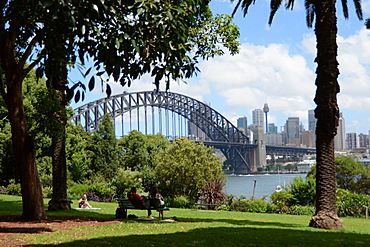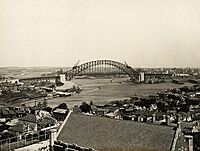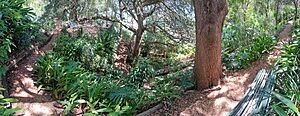Lavender Bay, New South Wales facts for kids
Quick facts for kids Lavender BaySydney, New South Wales |
|||||||||||||||
|---|---|---|---|---|---|---|---|---|---|---|---|---|---|---|---|

Clark Park, Lavender Bay
|
|||||||||||||||
| Population | 941 (2016 census) | ||||||||||||||
| • Density | 4,700/km2 (12,000/sq mi) | ||||||||||||||
| Postcode(s) | 2060 | ||||||||||||||
| Area | 0.2 km2 (0.1 sq mi) | ||||||||||||||
| Location | 3 km (2 mi) north of Sydney CBD | ||||||||||||||
| LGA(s) | North Sydney Council | ||||||||||||||
| State electorate(s) | North Shore | ||||||||||||||
| Federal Division(s) | North Sydney | ||||||||||||||
|
|||||||||||||||
Lavender Bay is a beautiful suburb right by the water in Sydney, New South Wales, Australia. It's on the lower North Shore, which is a part of Sydney north of the famous Sydney Harbour Bridge. This lovely area is only about 3 kilometres north of Sydney's main city centre. It's known for its amazing views of Sydney Harbour.
The suburb gets its name from Lavender Bay itself. This is a natural part of Port Jackson (Sydney Harbour). It sits between Milsons Point and McMahons Point. The suburb of North Sydney is just to the north. Lavender Bay is mainly a place where people live, and it offers fantastic views of the harbour.
Contents
History of Lavender Bay
The name "Lavender Bay" comes from George Lavender. He was a "bosun" (a type of ship's officer) on an old prison ship called the "Phoenix". This ship was anchored in the bay for many years.
The local Aboriginal people, the Cammeraygal people of the Eora nation, called the bay Gooweebahree. This name is sometimes also written as Quiberee in the Dharug language. Early European settlers also called it Hulk Bay or Phoenix Bay. George Lavender lived on land next to another well-known early resident, Billy Blue.
On May 30, 1915, the Lavender Bay railway station was opened. It was meant to replace the Milsons Point railway station. However, this only lasted for seven weeks. Passengers wanted trains to stop at Milsons Point instead. During the building of the Sydney Harbour Bridge, Lavender Bay Station was the end point for the North Shore train line. Today, this area is used for storing trains.
Important Historic Places
Lavender Bay has some places that are protected because of their history. These are called heritage-listed sites. One of them is:
- 1 Walker Street: Brett Whiteley House
People Living in Lavender Bay
In 2016, a survey called the Census counted 941 people living in Lavender Bay. About 57% of these people were born in Australia. Most people, about 76%, spoke only English at home. When asked about their religion, the most common answers were "No Religion" (33.4%) and "Catholic" (26.4%).
Famous Landmarks
- There is a wharf in the bay. A wharf is a structure built out into the water where boats can dock. This one is used by private boats.
- The Lavender Bay Baths were a popular swimming spot. These were tidal swimming pools, meaning the water level changed with the tides. They were built in 1910 near the ferry wharf.
- Wendy's Secret Garden is a special garden created by Wendy Whiteley. It's located next to her home, between Clark Park and the old railway line. This beautiful garden is open for everyone to visit and enjoy.
Churches in the Area
- Christ Church, Lavender Bay is a well-known church on the Lower North Shore.
- The Jesuit Church of St Francis Xavier was started in 1856. It is now part of the North Sydney Parish.
Famous People Who Lived Here
- Sir Donald Bradman was a very famous Australian cricketer. He lived on Bay View Street, right by the harbour. He was one of the first Australians to get a private telephone number!
- The artist Norman Lindsay lived in a house called 'Heidelberg' at 9 Bay View Street. Many years later, another artist named John Firth-Smith also lived in the same house.
- The artist Brett Whiteley lived in a house overlooking Lavender Bay with his wife, Wendy Whiteley. Wendy continued to live there in 2019. In 2018, the New South Wales Government gave special heritage protection to the Whiteleys' house, its harbour views, and Wendy's amazing Secret Garden. This was to recognise how important the place is to Australian art history.




